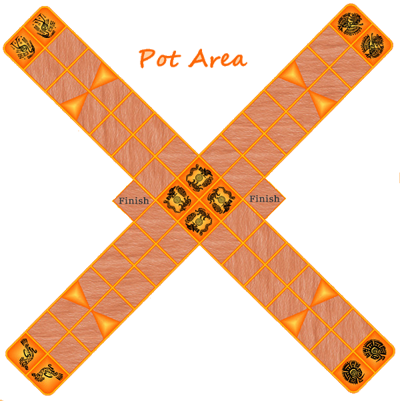Patolli - Professor Finkel's Rules
(Mostly)
(Adapted rules as taken from https://a4games.company)


1. Patolli is played on a cross-shaped board of sixty squares. Eight of those squares are reduced in size by wedge-shaped markings between them. Eight more at the ends of the cross are rounded.
2. Each player has six pieces. The pieces for each player are distinguished by colour. The players begin the game with pieces on their side of the board, Red on the left-side, Green on the right-side.
3. Five sticks control the movement of the pieces. They are marked on one side and blank on the other. The score of the sticks when thrown is one point per marked side showing, or ten points if all five marked sides are shown. When no marked sides show, there is no score.
4. Each player puts a stake of twenty coins into the pot.
5. The sticks are thrown by each player at the start of the game. The Red player begins, throwing the sticks as in rule 6.
6. The player whose turn it is throws the sticks. If there is no score, the turn is over.
7. On his first turn the player enters a new piece onto the board from the
central square closest to him, moving around the track by the number of
spaces according to his score. He decides the direction of movement for his own pieces, clockwise or anti-clockwise; he will maintain this direction
throughout the game, but each player makes his own choice. Pieces may
therefore run in the same or opposite directions during the game.
8. Once a player has one piece on the board, others may be entered only on a throw of 1. A throw of 1 does not necessitate the entry of a new piece, however; the player may opt to move a piece already on the board instead.
9. When a player has more than one piece in play, the player may choose to move any one piece in accordance with the throw.
10. A piece may not land on an occupied square. If it would do so, then it
cannot be moved and another piece must be moved instead. It is possible
that no piece can be moved by a particular throw. There is one exception
to this rule. Pieces in the four squares in the middle of the game are
vulnerable to attack on pain of a penalty.
11. If the player can move, then he must move, even if all available moves
are detrimental.
12. If the player cannot move, then he must pay a penalty into the pool.
13. A player landing in one of the reduced squares beside the wedge
markings must pay a penalty.
14. A player landing in one of the rounded squares at the end of the cross
receives another turn.
15. After having made a complete circuit of the board, a piece is borne off on
reaching the last square (i.e. the one before the player's starting square) by
an exact throw. On bearing off a piece, the player receives a bonus coinfrom the pot.
16. The player who has borne off the last of his pieces wins the game and
the contents of the pot.



